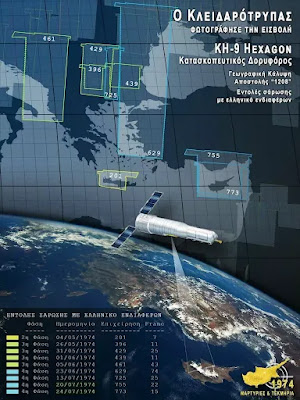Filenews 22 June 2024
Since April 21, 1974, an American high-altitude spy plane has been stationed at the British Bases of Akrotiri, namely the U-2 Dracon Lady (Draculina), which has a long history, considering that it was also used to take photographs during the Turkish invasion.
The historical researcher and expert in geographic information systems (GIS) and remote sensing, Mr. Odysseas Christou, told "F" that in April 2014 the 40th anniversary of the relocation of U-2 planes in Cyprus was celebrated.
Mr. Christou, on the occasion of the publication last Saturday in "F" of photographs of the period of the Turkish invasion of 1974 by an American satellite, said that the planes of the Draculina squadron arrived in Cyprus in the framework of the operation OLIVE HARVEST concerning the surveillance of the peace agreement between Egypt and Israel.
Regarding the action of the US satellites that recorded the Turkish invasion, Christou says that from the data he examined (after their release in 2020) these satellites had previously photographed areas of Northern Greece. Two days before the coup d'état of July 14, 1974, dense photographs were recorded at the height of Sofia (the capital of Bulgaria). According to Christou, there were reports that Greece would be attacked by Bulgaria, which was not confirmed.
During the same period (shortly before the Turkish invasion) satellites of the then Soviet Union were also active over Cyprus. Two days before the coup, a satellite is launched, and on July 25 and 26, new satellites are launched. On August 7, the Russians launch a new satellite.
As already published on Saturday in "F", the Americans apparently reacted when they perceived the action of Russian satellites, and on August 13 (a day before the start of the second Turkish invasion) the Washington Post published an article in which it reported that the Russians launched a new satellite and put it into orbit over Cyprus. The news was republished in newspapers in Greece by Phileleftheros.
According to Christou, the monitoring of events in Cyprus had provoked, at the time, controversy between US agencies.
Thomas Boyatt joined the U.S. Department of State in 1959 and from 1967 to 1970 he was a political advisor and from 1971 to 1974 he was Director of the Office of Cyprus Affairs. On August 9, he submitted a Memorandum of Protest highlighting the weaknesses of the intelligence analysis mechanism, which did not foresee the coup in Cyprus, resulting in the surprise of the US services, as he claimed.
Subsequently, an audit of the flow of information known as the "CYPRUS COUP POST-MORTEM REPORT" was ordered, which on September 10, 1974 had been handed over to the then Secretary of State Henry Kissinger. The issue assumed great proportions and came to be discussed in the competent committee of the US House. The committee's report became known as the Pike Committee Report. On February 13, 1976, there were reports in the Cypriot press, along with Kissinger's then statement/threat to resign due to the revelations.
At that time, responsibilities were also sought from the COMIREX committee, which evaluated the targets to be photographed and ranked them in order of priority.
COMIREX was not satisfied with the draft conclusion and commented and suggested that some paragraphs be reworded. The relevant classified documents were identified by researcher Odysseas Christou and as he told us contained valuable information that helped form a better picture in the context of his research.
In response to our question, Mr. Christou told us that there were two events that could potentially be recorded by spy satellites and had a decisive role in the coup, but they are difficult to interpret unequivocally. Assessments of their contribution to the coup's success were also conflicting.
These facts are:
a) The detachment of a battalion of T34 tanks from the camp of Kokkinotrimithia to the camp of BMH.
b) The transfer of the headquarters of the 9th Tactical Group and the abandonment of its camp adjacent to the presidential one.
Regarding the spying tools used at the time, Mr. Christou says that the secrets released decades later show that the following satellites were active:
A) The KH-8 Gambit satellite, which between 17 and 21 July photographed Cyprus while it was at the end of its mission. The data and details of the mission of this satellite are classified and only hypotheses can be made. Christou believes he recorded the troop build-up on Turkey's coast before the invasion and the bridgehead after the Five Mile landing.
B) The KH-9 Hexagon satellite took pictures from an altitude of 150 km and on July 20 and 24 recorded Turkey (Adana, Instirlich, Mersin) and the whole of Cyprus. This data has been declassified and has been under investigation since 2020.
